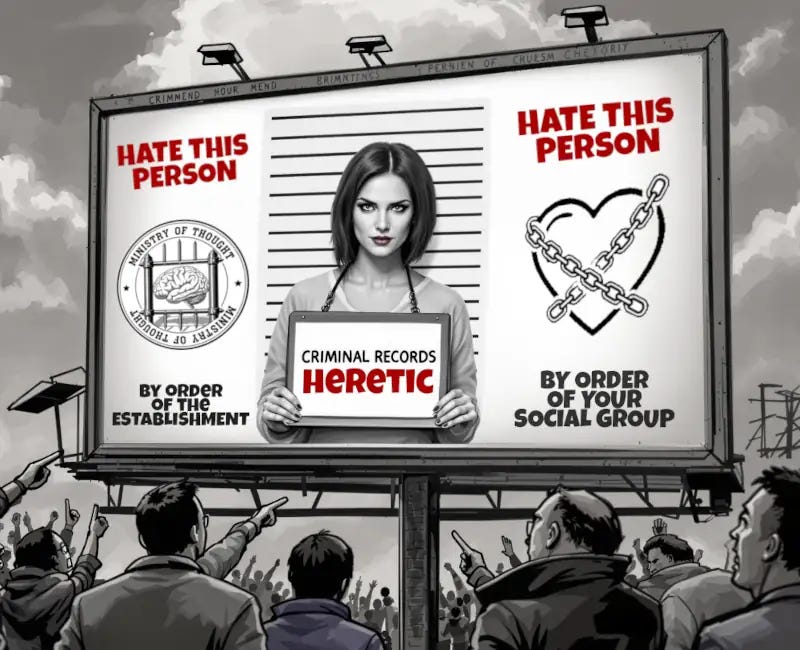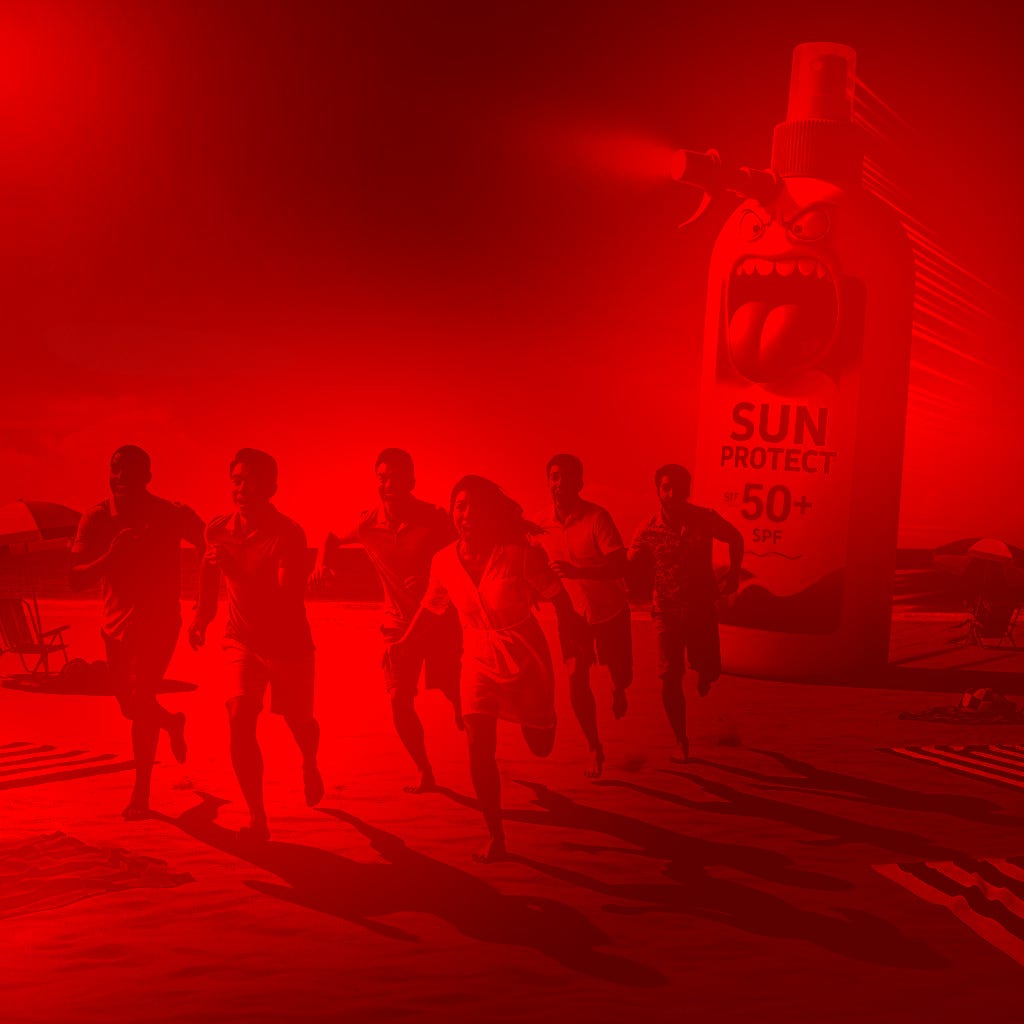How genuine concerns are rebranded as conspiracy theories
The disease of ignorant authoritarianism infesting UK media
On Sunday 24th August 2025, the Independent rolled out the dog-whistle term ‘conspiracy theory’ in a science-denial article written by a lifestyle correspondent. The ‘journalist’ in question was Katie Rosseinsky, a young lady whose ambitions lie firmly within establishment media. Like the BBC article I analysed in June, Katie chose to frame her piece within the ‘conspiracy theory’ genre, attempting to dismiss, rather than discuss, concerns over the harmful effects of certain sunscreen ingredients.
Conspiracy theory is an emotive label, popular with journalists who don’t understand science, or whose career goals take precedence over any concern for accurate public information; often, both. What’s striking about Katie’s article is that she didn’t need to use the term conspiracy theory at all. So, why did she? I’ll come to that shortly. First, let’s look at what the article said.
In essence, the message was that large numbers of people were rejecting the use of sunscreen based on the idea that sun exposure is less of a risk than using sunscreen, and this idea is wrong, unscientific, and caused by conspiracy theories. Actually, the use of sunscreen and the health benefits of sun exposure is a highly complex issue. Sadly, Katie attacked it like a child kicking over a chess board before declaring victory.
In order to suggest gen Z are, well, a bit dim, Katie refers to a study that was conducted in the US, not the UK. It was based on a sample of around 1000 adults, not exclusively gen Z. The data isn’t available from the link Katie provided, nor is the original peer-reviewed research article (if there was one?) However, with it being a stratified sample, it’s likely that around 10-15% of respondents were in the 18-26 age group. So, perhaps 100 to 150 people. That’s a weak research method with low statistical power for specific age groups.
(Gen Z aren’t dim either BTW. They have their share of idiots of course, and they’re subject to a more insidious type of brainwashing and educational erosion, but overall I’d say they were more intelligent, more sensitive, and significantly more disadvantaged overall than older, living generations. That said, I’d discourage people from using generational categories because similarly aged people can be dramatically different.)
The study referred to in the Independent did find that appearance, rather than health, was a significant factor for people who desired a tan. However, Katie’s article in the Independent doesn’t mention cosmetic concerns. It’s a fact that good looks can change life outcomes substantially. Looks are linked to better pay, more respect, better life opportunities, and, yes, better care from health workers. None of that is deserved, it just taps into unconscious biological drives, shaped by the evolutionary psychology of primates. This ignorant, narcissistic focus, fomented by contemporary society, could have been a better talking point than conspiracy theories, don’t you think?
Another critical issue concerning sun exposure is the synthesis of vitamin D by the skin (and liver, which is integral to the process of making ‘active’ vitamin D). Again, this is something ignored altogether in Katie’s commentary. Vitamin D is essential for health, and low levels are associated with all manner of deleterious effects and chronic health conditions, including cancer. Notably, low vitamin D was linked to higher incidence of death and disease during the pandemic. No vitamin D mentioned in an article about sun exposure and health?
While Katie ignored vitamin D, she was keen to associate the pandemic with her anti-science ‘conspiracy theory’ hatchet job, making a bizarre association between those who questioned the safety of the dangerous experimental vaccine and rising incidence of skin cancer.
Genuine concerns over sunscreen are far more complex than those given brief mention in the article by Katie or any of her ‘experts’. You can read my mini-review covering some issues with sun cream toward the bottom of my article titled ‘Conspiracy theories will kill you says BBC’. In brief, there are formulas containing chemicals that can lead to a range of health issues and chronic illness. These chemicals weren’t supposed to get into your body, but they do. A key concern relates to the ingredient octocrylene which increases absorption rates of other harmful ingredients. Plus, some sun creams fail to provide the protection advertised. And, of course, there are issues with industry-led science, lobbying, corruption, contamination, and the general overload of the human body due to our toxic environment. Such concerns are dismissed by the Independent, based on an authoritarian statement from an ‘expert’ who says sunscreen must be safe and effective because it ‘ … will “have been rigorously tested and approved by regulatory authorities in the UK, Europe and the US”.’ Oh, dear. Someone hasn’t honed their critical thinking, have they?

A useful article would have covered the multiplex of issues in a more informed manner. It would have acknowledged the trade-off between competing risks including lack of sun exposure, over exposure, general toxicity, and cosmetic concerns. It would have mentioned the range of alternatives that could be used, including long-sleeves and hats. A little understanding would have been nice too. Those who have quite rightly lost all faith in corrupt corporations, biased establishment science, and inept general governance, are acting quite rationally in their intentions when preparing their own sun protection, even if they get the chemistry wrong. This isn’t due to a conspiracy theory, it’s rational, evidence-based scepticism about commercial products and the corrupting influence of profit and personal gain.
Katie Rosseinsky didn’t write anything useful, though. Instead, she chose to publish a piece of deep-state propaganda conflating skin cancer, conspiracy theories, and critics of the harmful, novel, experimental vaccines rolled out under cover of a carefully orchestrated global panic.
I don’t mean that she did this deliberately. Maybe she is a deep-state operative, helping groom the population for the next stage of tyranny, but it seems unlikely. However, propaganda doesn’t require conscious will to reproduce. I have no doubt that Katie knows who she wants to please. Rich rewards await those who become entrenched within established media. So, instead of penning a proper scientific analysis, she chucked out a hotchpotch story intent on psychological ‘nudging’. Her writing makes a mockery out of a serious concern.
Perhaps she’s friends with Marianna Spring, or wants to be? A preoccupation with the term ‘conspiracy theory’ suggests questionable motives, as does the narrative of a terrible proliferation of medical misinformation during the pandemic. The latter was true, of course, but it was done by those Katie mistakenly, and ignorantly, places her trust in. And it was aided and abetted by careerist journalists who don’t actually understand the complexity of the topics they’re writing about.
I’ll conclude by sharing some facts.
• If you take unnecessary risks with sun exposure, or use sun beds, you might end up with skin cancer, and it’s pretty deadly. So, don’t be blasé about it.
• If you don’t get sufficient sun exposure, you can end up with vitamin D deficiency, and that’s extremely harmful in many ways. Supplementation is possible, and can increase blood plasma levels, but it may not efficiently reach places it needs to be, especially if there’s endothelial dysfunction interfering with its passage.
• It’s impossible to accurately determine the cause of cancer from cancer cells. Most statistics are based on assumptions, and in the case of skin cancer, those assumptions have failed to account for the carcinogenic effects of a whole host of substances and risk factors that are not solely UV light; that includes the harmful chemicals in some sunscreens, and the false protection claims of others.
• Skin cancer rates have increased despite people spending less time outdoors on a regular basis, and overall. This is linked to indoor working, increased outdoor dangers such as other people and traffic, less outdoor space in urban areas, more households with smaller gardens or none at all, and the exponential increase in screen-based entertainment.
• The fact that people now spend more time indoors has caused a proliferation of vitamin D deficiency and a host of associated illness and disease.
• Studies have found RF radiation to be harmful to skin, and capable of altering gene expression profiles.
• While exposure to the sun has decreased, there has been an exponential increase in skin exposure to RF radiation over the last few decades.
Sources:
Grant, W. B., Bhattoa, H. P., & Pludowski, P. (2018). Determinants of vitamin D deficiency from Sun exposure: a global perspective. In Vitamin D (pp. 79-90). Academic Press.
Maxwell, J. D. (1994). Seasonal variation in vitamin D. Proceedings of the Nutrition Society, 53(3), 533-543.
Mendes, M. M., Darling, A. L., Hart, K. H., Morse, S., Murphy, R. J., & Lanham-New, S. A. (2019). Impact of high latitude, urban living and ethnicity on 25-hydroxyvitamin D status: a need for multidisciplinary action?. The Journal of steroid biochemistry and molecular biology, 188, 95-102.
Mithal, A., Wahl, D. A., Bonjour, J. P., Burckhardt, P., Dawson-Hughes, B., Eisman, J. A., ... & IOF Committee of Scientific Advisors (CSA) Nutrition Working Group. (2009). Global vitamin D status and determinants of hypovitaminosis D. Osteoporosis international, 20(11), 1807-1820.
Mullan, K. (2019). A child's day: trends in time use in the UK from 1975 to 2015. The British Journal of Sociology, 70(3), 997-1024.
Neale, R. E., Lucas, R. M., Byrne, S. N., Hollestein, L., Rhodes, L. E., Yazar, S., ... & Olsen, C. M. (2023). The effects of exposure to solar radiation on human health. Photochemical & Photobiological Sciences, 22(5), 1011-1047.
Saternus, R., Vogt, T., & Reichrath, J. (2019). A critical appraisal of strategies to optimize vitamin D status in Germany, a population with a Western diet. Nutrients, 11(11), 2682.
Sowah, D., Fan, X., Dennett, L., Hagtvedt, R., & Straube, S. (2017). Vitamin D levels and deficiency with different occupations: a systematic review. BMC public health, 17(1), 519.
Spiro, A., & Buttriss, J. (2014). Vitamin D: an overview of vitamin D status and intake in E urope. Nutrition bulletin, 39(4), 322-350.
https://www.statista.com/chart/21408/time-americans-spend-indoors-outdoors
[Accessed 25 August 2025]
Williams, A. M., & Shaw, G. (2009). Future play: tourism, recreation and land use. Land Use Policy, 26, S326-S335.
Wilson-Barnes, S. L. (2020). The inter-relationship between vitamin D status, bone health and physical performance in university athletes (Doctoral dissertation, University of Surrey).
Zittermann, A., Schleithoff, S. S., & Koerfer, R. (2005). Putting cardiovascular disease and vitamin D insufficiency into perspective. British journal of nutrition, 94(4), 483-492.
Read a full review of the health effects of electrosmog here >>> https://toxictreadmill.com/poisonplanet/electroMagneticRadiationFields.htm





